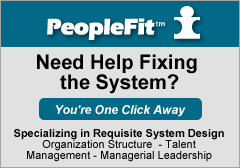Using Requisite Science to Design Work-Enabling Organizations
By Michelle Malay Carter on December 20, 2007
 This post is a continuation from yesterday’s post in which I mentioned that we were able to predict the turnover of specific individuals within a client’s?organization.? I promised to tell you more on how we spot?under-utilization?today.
This post is a continuation from yesterday’s post in which I mentioned that we were able to predict the turnover of specific individuals within a client’s?organization.? I promised to tell you more on how we spot?under-utilization?today.
Management Science Should Take a Page from Physical Science
An analogy:? An understanding of work levels and its relationship to levels of human?problem solving capability?is to management science what the understanding of?energy and its relationship to temperature is to physical science.
Simple Tools and Engineering Templates Allow for the Easy and Practical Application of Scientific Theory?
When the thermometer became a tool for the easy, practical application of scientific laws toward predicting the “behavior” of matter, our ability to engineer our physical world to our benefit improved dramatically.
For example, not only could we now observe that H2O?existed in three different states (ice, water, steam),?the thermometer allowed us to?reliably forecast when these states would change.
Back to (Little Known) Management Science
1.? Not all work is the same.? Work exists in discreet levels of complexity, and any given work role can be categorized?by level.? Time span of discretion allows us to measure this.
2.? Raw talent capability to solve problems in humans exists (independent of experience, education, or knowledge) and it?can be categorized by level.? Managers, given a common language and framework for interpretation, can reliably judge their employees’ capability levels.
3.? Human problem solving capability levels can be aligned one-for-one?with work levels.?
Need Proof, Want Research?
If you would like to read more on the management science part, you can access the 210-page Requisite Organization annotated research bibliography or 1010 pages of dissertations on the theory by clicking here.
The Turnover Prediction Part?- Continued from Yesterday’s Post
Under normal circumstances, people prefer working in a role that matches their current problem solving capacity level.? In other words, if I have level 3 problem solving capability, I will be best suited to work at a level 3 role.? I cannot yet work at level 4; I will be underutilized at level 2.
Therefore, employees who are underutilized, i.e. have problem solving capability above that called for by their role, represent an organization’s highest risk population?for turnover.? Underutilized employees will want more challenge and will look for it either within your organization or elsewhere.
Managerial Leadership Tools and Organizational Engineering Templates?Based on Scientific Theory
Tools do exist for the easy practical application of work levels theory toward predicting the behavior of employees.? Hence, our ability to engineer our organization’s systems to tap full potential is one benefit of using work levels theory to design work enabling systems.? Other applications of the theory can benefit organizational?effectiveness in a variety of ways.
Further, work levels is just one piece of the meta-model,?Requisite Organization,?which offers an integrated approach?for organization design, managerial leadership, and talent management.? It’s not rocket science; it’s people science.? I suspect the job title, organizational engineer, will be mainstream one day.
I’m OK.? You’re OK.? Let’s fix the system.
Questions?
Filed Under Employee Engagement, Executive Leadership, High Potential, Managerial Leadership, Organization Design, Requisite Organization, Talent Management
Comments
3 Responses to “Using Requisite Science to Design Work-Enabling Organizations”

[…] Ignoring validated management science is understandable?when you realize that it will take discipline, maturity, and hard work over years to?re-engineer their current systems and organizational structure to make productive use of the scientific principles that already exist. […]
[…] to add a CEO. What PeopleFit could do for Adaptive Path that few others could is use a validated, science based approach to assess the work complexity level of the proposed CEO role and then screen their candidates for […]
[…] Organization Design Because we don’t understand work levels, we are unable to design requisite work enabling organizations.? We are paying a huge price both monetarily and in quality of […]